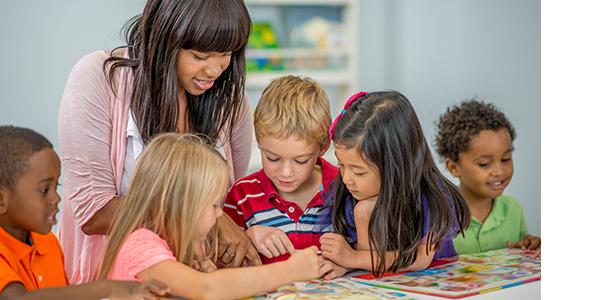Knowledge-Rich Curriculum: Supporting Positive Identity Development and Advancing Equity

You are here
“Each and every child, birth through age 8, has the right to equitable learning opportunities—in centers, family child care homes, or schools—that fully support their optimal development and learning across all domains and content areas.”
With the launch of its updated hallmark position statement at the 2020 Annual Conference, NAEYC continues to define for the field what developmentally appropriate practice means in early childhood education. Working in tandem with the Advancing Equity in Early Childhood Education position statement, the call to action is clear: “All children have the right to equitable learning opportunities that help them achieve their full potential as engaged learners and valued members of society.”
Within a developmentally appropriate, equitable learning community and environment, this Young Children cluster advocates a curriculum that is knowledge-rich, that is authentically connected to children’s social and cultural contexts, and that promotes positive perceptions of social identities. It delves into what children should know and why; how teachers can engage children in knowledge-rich, identity-enhancing learning experiences; and how teachers can connect with expertise and resources in all children’s homes and communities.
Opening the cluster is “The Power of Knowledge to Transform Teaching and Learning” by Adrienne Williams. Drawing from her experiences teaching first grade, Williams outlines a rationale for a knowledge-building curriculum and the three significant shifts that occurred when she implemented this new curriculum. By having students read more complex texts, by embedding writing within an overarching topic, and by incorporating diverse perspectives, Williams fostered more joyful learning and a greater sense of efficacy in her first-graders.
In “Never Too Young to Champion a Cause,” Veronica Benavides, Roxanne Ledda, and Maimuna Mohammed describe one center’s quest to design and deliver a content-rich, identity-developing curriculum anchored by effective family partnerships and culturally responsive practices. Their initiative illustrates that preschoolers can learn about and take action on local and global issues —ranging from a lack of accessible and nutritional food choices in the local community to a lack of accessibility and conservation of water in the global community—while gaining essential knowledge and skills across the curriculum. Indeed, “the children may be small, but their message is big!”
Also with an emphasis on building on the assets of families and communities, Christine M. McWayne and colleagues write about “Incorporating Knowledge from Children’s Homes and Communities: A Home-to-School Approach for Teaching STEM in Preschool.” These authors detail how teachers can listen to and observe children and indirectly and directly learn what families know and do in the everyday (about plants, nutrition, water pipes, home structures, and musical instruments) in order to enact a home-to-school approach that promotes knowledge and identity development.
Hillary A. Libnoch and Jackie Ridley offer an in-depth look at “Using Picture Books about Refugees: Fostering Diversity and Social Justice in the Elementary School Classroom.” Echoing earlier articles in the cluster, the authors recognize the power of texts (in this case, picture books) to help young children build historically accurate background knowledge and perceptions of refugees. They detail how to select and use picture books about refugees, and they include a sample unit.
Rounding out the cluster, Katie E. Luedtke details the hard work and lessons learned by her elementary school community in their journey to find, implement, and adapt to a knowledge-rich curriculum in “Snippets of Conversation: How Knowledge-Rich Curriculum Can Change a School Community.” Luedtke depicts the triumphs and challenges of a major curriculum change, and she writes about what they learned as students and teachers, ultimately, reached new heights in their learning and teaching.
Each cluster article showcases that it is a journey to attain a knowledge-rich, equitable curriculum. Whether planning for preschoolers or third-graders, such a curriculum depends on strong collaborations within a school community and with families, sustained professional learning and support, ongoing reflection paired with intentional practice, and an unwavering belief in all children’s capacity to learn.
As you will read in the final column from the devoted historian and passionate advocate Edna Runnels Ranck, our field has endured significant challenges in our history and at present, and the path forward will not be easy. Still, “Early care and education professionals and advocates must . . . pursue it with purposeful intention. This much is owed to the children of this country and of the future.” I hope these articles, with their clear call to action, provide you with the guidance you need to advance in your own journey toward creating and using a knowledge-rich, identity-building, and equitable curriculum in your setting.
—Annie Moses


A self-portrait of a 4-year-old looking out his bedroom window and thinking about all the places he would like to go.
Is your classroom full of children’s artwork? To feature it in Young Children, see the link at the bottom of the page or email [email protected] for details.
 We’d love to hear from you!
We’d love to hear from you!
Send your thoughts on this issue, and on topics you’d like to read about in future issues of Young Children, to [email protected].
Would you like to see your children’s artwork featured in these pages? For guidance on submitting print-quality photos (as well as details on permissions and licensing), see NAEYC.org/resources/pubs/authors-photographers/photos.
Annie Moses, PhD, is director of periodicals at NAEYC and serves as editor in chief of Young Children and Teaching Young Children.
